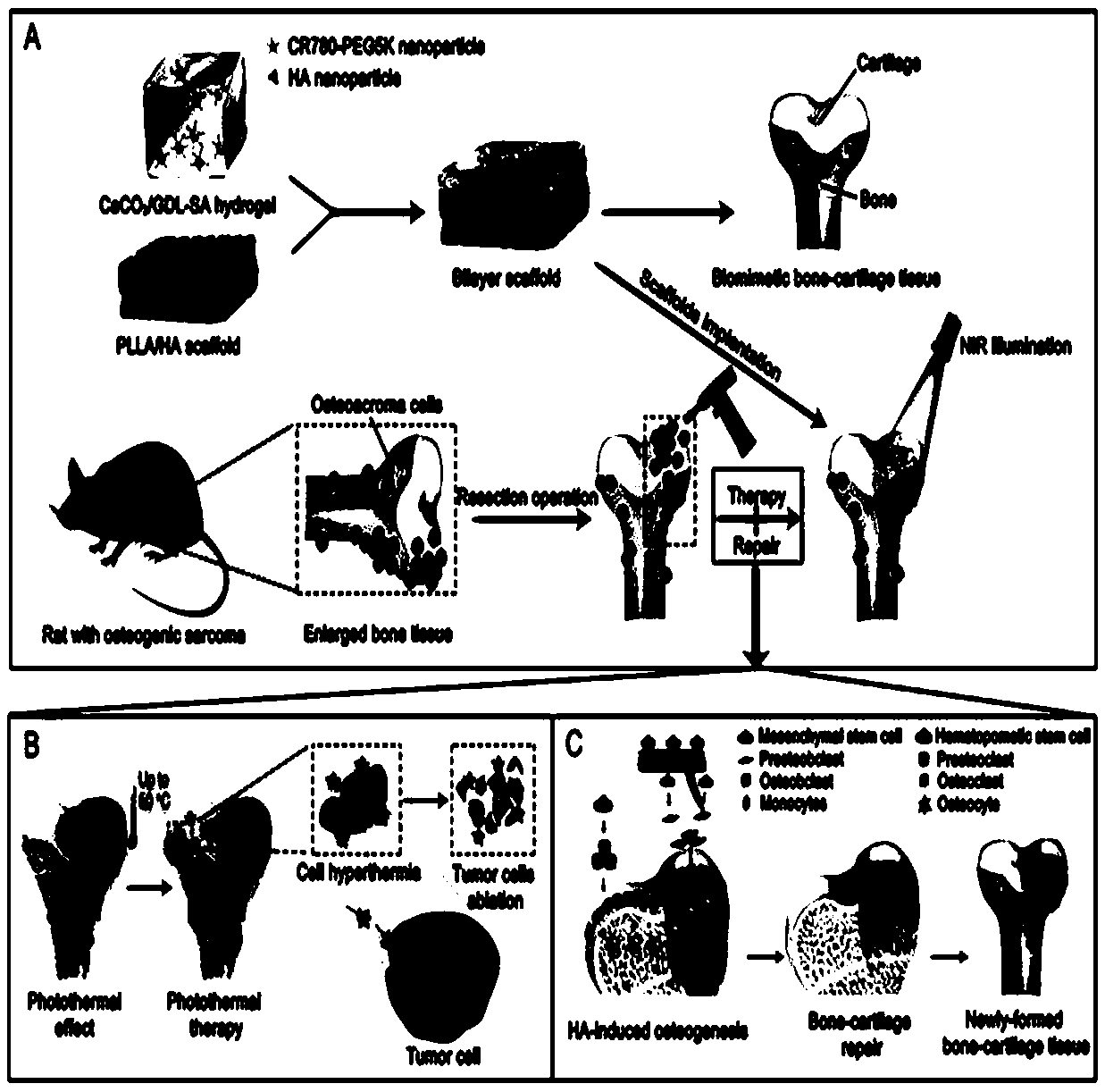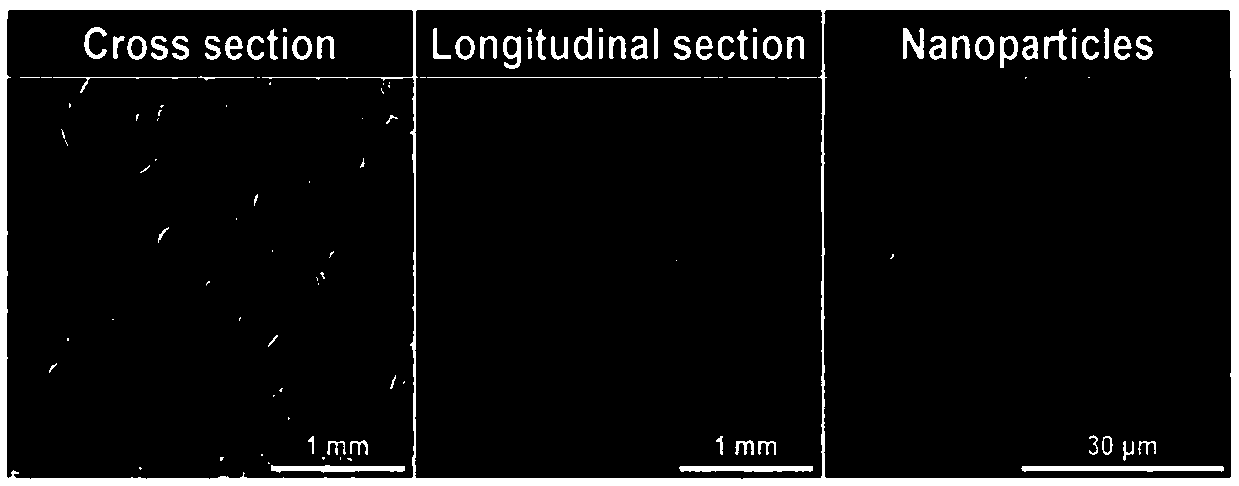Difunctional integrated bone-cartilage composite tissue engineering scaffold for clinic treatment of osteosarcoma
A clinical treatment and composite tissue technology, applied in tissue regeneration, prosthesis, anti-tumor drugs, etc., to achieve the effect of promoting simultaneous regeneration, good photothermal effect, and improving interface compatibility
- Summary
- Abstract
- Description
- Claims
- Application Information
AI Technical Summary
Problems solved by technology
Method used
Image
Examples
Embodiment 1
[0052] (1) Prepare a certain concentration of PLLA / chloroform solution (8%, W / V ), then weigh a certain amount of HA (the mass fraction of HA in PLLA / chloroform solution is 15%, W / V )) dispersed in PLLA / chloroform solution, and ensure the uniform distribution of HA in the polymer matrix to obtain PLLA / HA solution;
[0053] (2) In order to prepare a hard bone scaffold with a certain pore size, NaCl particles with a weight ratio of NaCl to PLLA / HA solution of 6:1 were sieved (180-90 mesh), and then slowly poured into the PLLA / HA solution, using Stir quickly with a glass rod until uniform, then pour into homemade glass molds;
[0054] (3) Put the mold in a fume hood to exhaust for 12 h, then put it in a vacuum oven set at 60 °C to dry for 24 h, and finally soak the formed hard bone scaffold in deionized water for 7 days to complete particle leaching Hole making;
[0055] (4) In order to improve the interfacial compatibility of the composite scaffold, a certain mass of NaOH par...
Embodiment 2
[0071] (1) Prepare a certain concentration of PLLA / chloroform solution (12%, W / V ), then weighed a certain mass of HA (the mass fraction of HA in PLLA / chloroform solution was 25%, W / V ) is dispersed in PLLA / chloroform solution, and ensures the uniform distribution of HA in the polymer matrix to obtain PLLA / HA solution;
[0072] (2) In order to prepare a hard bone scaffold with a certain pore size, NaCl particles with a weight ratio of NaCl to PLLA / HA solution of 6:1 were sieved (180-90 mesh), and then slowly poured into the PLLA / HA solution, using Stir quickly with a glass rod until uniform, then pour into homemade glass molds;
[0073] (3) Put the mold in a fume hood to exhaust for 18 h, then dry it in a vacuum oven at 65 °C for 30 h, and finally soak the formed hard bone scaffold in deionized water for 10 days to complete particle leaching Hole making;
[0074] (4) In order to improve the interfacial compatibility of the composite scaffold, a certain mass of NaOH particle...
Embodiment 3
[0080] (1) Prepare a certain concentration of PLLA / chloroform solution (8%, W / V ), then weigh a certain amount of HA (the mass fraction of HA in PLLA / chloroform solution is 15%, W / V ) is dispersed in PLLA / chloroform solution, and ensures the uniform distribution of HA in the polymer matrix to obtain PLLA / HA solution;
[0081] (2) In order to prepare a hard bone scaffold with a certain pore size, NaCl particles with a weight ratio of NaCl to PLLA / HA solution of 7:1 were sieved (180-90 mesh), and then slowly poured into the PLLA / HA solution, Stir quickly with a glass rod until uniform, then pour into homemade glass molds;
[0082] (3) Put the mold in a fume hood to exhaust for 12 h, then put it in a vacuum oven set at 55 °C to dry for 12 h, and finally soak the formed hard bone scaffold in deionized water for 7 days to complete particle leaching Hole making;
[0083] (4) In order to improve the interfacial compatibility of the composite scaffold, a certain mass of NaOH partic...
PUM
| Property | Measurement | Unit |
|---|---|---|
| Mesh | aaaaa | aaaaa |
| Density | aaaaa | aaaaa |
| Average modulus | aaaaa | aaaaa |
Abstract
Description
Claims
Application Information
 Login to View More
Login to View More - R&D
- Intellectual Property
- Life Sciences
- Materials
- Tech Scout
- Unparalleled Data Quality
- Higher Quality Content
- 60% Fewer Hallucinations
Browse by: Latest US Patents, China's latest patents, Technical Efficacy Thesaurus, Application Domain, Technology Topic, Popular Technical Reports.
© 2025 PatSnap. All rights reserved.Legal|Privacy policy|Modern Slavery Act Transparency Statement|Sitemap|About US| Contact US: help@patsnap.com



